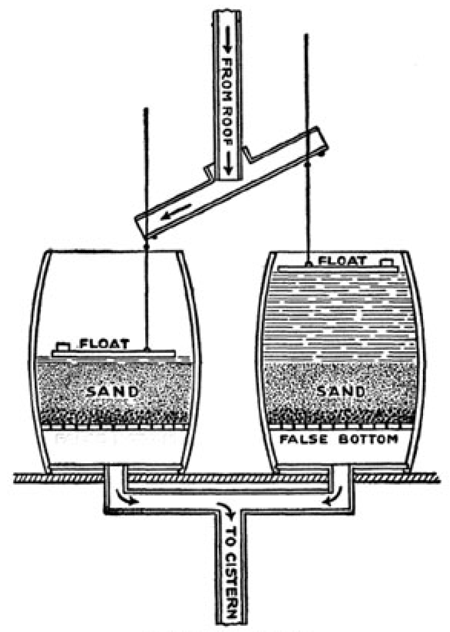Low Tech: No-Power Water Filtering Barrels
Rain water barrels have been all the rage for the last couple years (unless, of course, you lived in one of those areas where the government “owns” the rainwater than falls from the sky). They’re an excellent way to provide for or supplement the water needs of a home garden. However, a lot of us forget that it was not too long ago that such measures (rain capture and cistern) were part of the life or death water supply of mankind in many area. With water collection comes the issue of purification. It was with all of this in mind that I came across this clever bit of farm technology from the last century. My hat’s off to the clever farm that built the first one of these from simple materials found on most farmyards without the need for power or industry.
Problems of Collecting & Filtering Rainwater
This solution solves two problems in one. The first is filtration. Even rainwater, particularly when collected from roofs and other surfaces can contain a significant amount of contaminant such as leaves, dirt, insects and whatnot. These pose a serious risk of spoilage when the water is stored for any amount of time (such as in a cistern). As you will see in the diagram and following text, the filtration concept is straight-forward and one that is advocated in many primitive and survival settings. Its environmentally friendly and renewable.
The second is handling unpredictable amounts of water from rain or run-off. Additionally, filtration slows down the flow of water by nature of the phhysical process of water passing through a porous medium. The unknown creator solved this problem by creating a clever two-barrel system that automatically switches water flow over to the second barrel until the first can cach up. The process is reversible, so water will automatically divert back and forth without need for human intervention, significantly decreases the likelihood that the system becomes overwhelmed.
Design & Construction of Two-Barrel Water Filtration System
 Two barrels, each with a perforated false bottom, are set side by side beneath the water spout from the roof and connected with a pipe leading to the cistern. Above the false bottoms fine gravel and then sand are packed to the depth of 8 or more inches. On top of the sand rest stout floats (cork board works well) as large as can be let down into the barrels. From near the margin of the floats two heavy wires extend vertically upward about 2 feet to engage loosely near their centers with a tilting spout by means of knobs on both the ends of the spout and the wires.
Two barrels, each with a perforated false bottom, are set side by side beneath the water spout from the roof and connected with a pipe leading to the cistern. Above the false bottoms fine gravel and then sand are packed to the depth of 8 or more inches. On top of the sand rest stout floats (cork board works well) as large as can be let down into the barrels. From near the margin of the floats two heavy wires extend vertically upward about 2 feet to engage loosely near their centers with a tilting spout by means of knobs on both the ends of the spout and the wires.
How the Two-Barrel Water Filtration System Works
When the barrels are empty the floats rest on the sand. As the water begins to pour in one barrel it strikes the float, but is prevented from gouging a very deep hole at the outside of the barrel by striking a strip of wood about 1 inch high, 2 inches wide and 1 foot long. This spreads the flow. A layer of gravel at this place would also help prevent gouging. If the flow is too great to filter away readily, the float will rise andthe knob on the wire will engage with the spout, which will be tilted until the flow will suddenly start into the other barrel. If the delivery pipe to the cistern be large enough there should be no danger of either barrel overflowing. When the sand becomes dirty a few minutes will serve to remove it and put in fresh.This will insure clean water in the cistern.
Additional Research:
 |
Leave a Reply